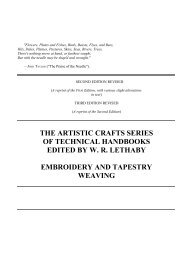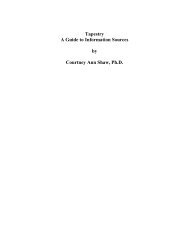3rd European textile and Fibre Art Festival - Catalogue
3rd European textile and Fibre Art Festival - Catalogue
3rd European textile and Fibre Art Festival - Catalogue
You also want an ePaper? Increase the reach of your titles
YUMPU automatically turns print PDFs into web optimized ePapers that Google loves.
HILTJE WIJNIA<br />
The Netherl<strong>and</strong>s / Nîderl<strong>and</strong>e<br />
Born 1949<br />
Star Numanwei 2<br />
8567JX Oudemirdum, The Netherl<strong>and</strong>s<br />
Education<br />
1994–1998 Academie voor Beeldende<br />
Kunsten, Maastricht, The<br />
Netherl<strong>and</strong>s<br />
Selected exhibitions<br />
2007 ”Suave 2”, Spanish<br />
National Museum of<br />
Costumes, Madrid, Spain<br />
”Sierwerk”, Museum<br />
Nairac, Barneveld, the<br />
Netherl<strong>and</strong>s<br />
2006 Tallinn Applied <strong>Art</strong><br />
Triennial – “Two Close<br />
Ones”, Tallinn, Estonia<br />
2004 Solo exhibition, Van der<br />
Tocht Museum,<br />
Amstelveen, the<br />
Netherl<strong>and</strong>s<br />
2003 Fries Museum, Leeuwarden,<br />
the Netherl<strong>and</strong>s<br />
2002 Schmuck 2002, München,<br />
Germany<br />
Schmuck, 2002,<br />
Kilmarnok, Scotl<strong>and</strong><br />
Galerie Slavic, Vienna,<br />
Austria<br />
Because of the increasing globalisation <strong>and</strong><br />
innovation, that has characterised the last<br />
decennium, many of our old habits <strong>and</strong> customs<br />
may get lost in the process. In my own<br />
way I want to ensure that such habits <strong>and</strong><br />
customs remain for future generations. I do<br />
so by using old techniques <strong>and</strong> thus transform<br />
old material forms into new objects.<br />
In my project “Laces” I felt - an old technique<br />
that originates from Far Eastern countries<br />
like Mongolia <strong>and</strong> Kirgyzia - antique laces<br />
(laces were used by the wealthy noble men<br />
<strong>and</strong> women <strong>and</strong> rich citizens in the 17th –<br />
18th century in Western Europe). In addition<br />
to felting the laces, I work my laces with<br />
knitted copper thread <strong>and</strong> pearls.<br />
The result of using these two techniques is<br />
beautiful lace collars, showing that the<br />
fragility of men <strong>and</strong> its materials may continue<br />
to exist, not withst<strong>and</strong>ing globalization.<br />
134






